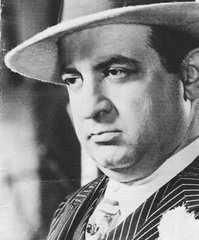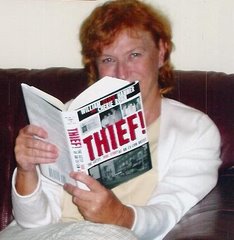
The following was posted June 24 on www.ChicagoSyndicate.blogspot.com Despite the negatives, it's still a worthwhile purchase for Bugsy fans. It's available on Amazon.com new for $12.99.
Don't Call Me Bugsy
A curious phenomenon occurs all too often with documentary films about organized crime. Even the most rational and high-minded documentarian tends to fall prey to the notion that they must adhere to the tropes of a gangster B-movie. Don't Call Me Bugsy, which details the rise and fall of Benjamin "Bugsy" Siegel, is no exception. From its self-consciously hardboiled voiceover narration to its formulaic presentation, the 70-minute doc is a passable, if unexceptional, examination of the underworld figure who helped create modern-day Las Vegas.
A curious phenomenon occurs all too often with documentary films about organized crime. Even the most rational and high-minded documentarian tends to fall prey to the notion that they must adhere to the tropes of a gangster B-movie. Don't Call Me Bugsy, which details the rise and fall of Benjamin "Bugsy" Siegel, is no exception. From its self-consciously hardboiled voiceover narration to its formulaic presentation, the 70-minute doc is a passable, if unexceptional, examination of the underworld figure who helped create modern-day Las Vegas.
Don't Call Me Bugsy touches on the essentials about Siegel, whose crazy temper earned him the sobriquet "Bugsy," a nickname he despised (hence the title of the flick). Born in Brooklyn, he aligned himself at an early age with fellow gangsters Meyer Lansky and Charles "Lucky" Luciano. Lansky was the brains of the outfit and Luciano the connection to the Sicilian Mafia, but Siegel possessed the murderous instinct that made him the favored triggerman. True-crime author Tim Power notes that the trio was undeniably vicious, but "it's impossible not to admire their energy, their drive."
As Prohibition ensured there was a fortune to be made trafficking in illegal booze, the Luciano-Lansky-Siegel alliance maneuvered to head criminal activities in New York and along the East Coast. In 1931, Siegel and three others killed old-school Mob boss Joe Masseria, setting the stage for the new generation of young Turks to transform organized crime into more of a streamlined business operation. But Siegel was restless for more adventure and, in 1935, relocated to Los Angeles. Enlisting the help of childhood-friend-turned-actor George Raft, Siegel dived into Beverly Hills society. His movie-star looks and roguish charm made him a favorite among polite society, particularly with rich women.
His most significant achievement, however, came when Lansky directed Siegel to spearhead the construction of the Flamingo Hotel in Las Vegas, Nevada. Gambling had been legal in the dusty desert town since the mid-1930s, but Lansky envisioned a gaming Mecca along the lines of what organized crime had built in pre-Castro Cuba.Siegel took to the assignment with a vengeance, sparing no expense in his desire to make the Flamingo a world-class destination. Nevertheless, costly delays and a ballooning budget assured his own demise. In 1947, Siegel was gunned down in his Beverly Hills home, a crime that remains unsolved.
The documentary intersperses black-and-white still photographs and archival footage with a handful of interviews from true-crime experts and various folks who knew Siegel, including his lawyer, barber and next-door neighbor. While the interviewees offer some juicy tidbits, they must compete with a hackneyed voiceover narration read by Larry Moran. When relating Siegel's 1926 arrest for rape, the narrator's sonorous voice tells us, "When it came to sex, he didn't discriminate. He didn't always ask, either." Siegel's longtime girlfriend, Virginia Hill, is described as "a feisty redhead from the foothills of North Carolina." Cue the eye-rolling. It's enough to make Mickey Spillane shudder.
It isn't a bad documentary, but it is uninspired and surprisingly lifeless. Too much of the film is a recitation of facts that don't shed much light on the subject. Only when we get to the saga of the Flamingo does Don't Call Me Bugsy really grab you, and most of that is due to rarely seen footage of Las Vegas in its early days.
The Video: The full-frame picture is solid but unremarkable. A few of the modern-day interviews suffer from softness, but much of the black-and-white archival footage is in very good condition.
The Audio: The 2.0 Stereo audio track gets the job done without any fanfare. The sound is somewhat flat, but you clearly hear the interviews and voiceover narrator, which is all that an audience would need.
English subtitles are available, but it should be noted that whoever is responsible for them evidently has little understanding of when a comma is necessary.
Extras: None.
Final Thoughts: Made in 1992, Don't Call Me Bugsy is a run-of-the-mill true-crime documentary that packs more information than it does illumination. The film chronicles Siegel's extravagant tastes for the Flamingo, but there is no speculation about what prompted it. What was his vision for Las Vegas? Did he even have a vision for it? People fascinated by organized crime (a group that includes your reviewer) would be better-served elsewhere, while viewers with only a casual interest are not likely to find much here worth their time.
Thanks to Phil Bacharach



No comments:
Post a Comment